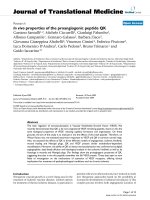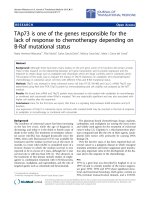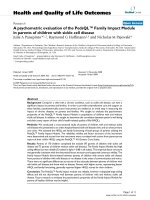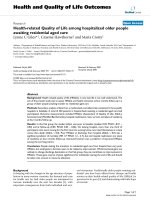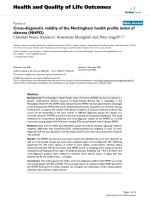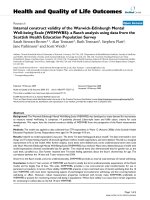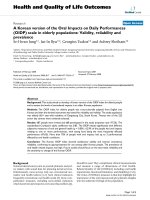Báo cáo hóa học: "Molecular Dynamics Simulations of the Roller Nanoimprint Process: Adhesion and Other Mechanical Characteristics" pot
Bạn đang xem bản rút gọn của tài liệu. Xem và tải ngay bản đầy đủ của tài liệu tại đây (742.06 KB, 8 trang )
NANO EXPRESS
Molecular Dynamics Simulations of the Roller Nanoimprint
Process: Adhesion and Other Mechanical Characteristics
Cheng-Da Wu Æ Jen-Fin Lin Æ Te-Hua Fang
Received: 5 March 2009 / Accepted: 24 April 2009 / Published online: 29 May 2009
Ó to the authors 2009
Abstract Molecular dynamics simulations using tight-
binding many body potential are carried out to study the
roller imprint process of a gold single crystal. The effect of
the roller tooth’s taper angle, imprint depth, imprint tem-
perature, and imprint direction on the imprint force,
adhesion, stress distribution, and strain are investigated.
A two-stage roller imprint process was obtained from an
imprint force curve. The two-stage imprint process inclu-
ded the imprint forming with a rapid increase of imprint
force and the unloading stage combined with the adhesion
stage. The results show that the imprint force and adhesion
rapidly increase with decreasing taper angle and increasing
imprint depth. The magnitude of the maximum imprint
force and the time at which this maximum occurs are
proportional to the imprint depth, but independent of the
taper angle. In a comparison of the imprint mechanisms
with a vertical imprint case, while high stress and strain
regions are concentrated below the mold for vertical
imprint, they also occur around the mold in the case of
roller imprint. The regions were only concentrated on the
substrate atoms underneath the mold in vertical imprint.
Plastic flow increased with increasing imprint temperature.
Keywords Roller imprint Á Nanoimprint Á
Molecular dynamics Á Nanotribology Á Taper
Introduction
With the increasing demand for nano/micropatterns on
large substrates, the establishment of large-scale nanofab-
rication technology has become a priority. In recent years,
nanoimprint lithography (NIL) has become a popular
method that offers a sub-10 nm feature size, high
throughput, and low cost [1, 2]. NIL fabricates nanopat-
terns by pressing a hard stamp with nanopatterns into a thin
film and deforming the film mechanically. A similar
approach to flat imprint lithography, roller nanoimprint
lithography (RNIL) with a sub-100-nm feature size, was
proposed by Chou et al. in 1998 [3].
Roller imprint technology such as gravure offset print-
ing and flexography printing offered an alternative
approach to large-scale pattern fabrication [4, 5]. Com-
pared with vertical NIL, RNIL has the advantages of pro-
ducing better uniformity, requiring less force, and being
able to repeat a mask continuously. However, most
research studies for both imprint technologies have focused
on experiments. Few studies have used the numerical
method. The transferred pattern will be significantly dam-
aged by a strong adhesion under smaller feature size.
Molecular dynamics (MD) simulation is an effective tool
for studying material behavior at the nanometer scale as it
provides detailed deformation information and the size
effect at the atomic level. Nanosystems that have been
analyzed using MD include surface friction [6, 7], nano-
scratch [8], lubrication [9], nanoimprint [10], contact [11],
and nanoindentation behavior [11–13]. Several studies
have recently investigated the NIL process using MD. The
nanopattern formation and physical mechanism were
investigated on metal film imprint by changing the imprint
temperature, imprint velocity [14], and stamp taper angle
[10, 15]. Kang et al. [16] studied the deformation behavior
C D. Wu Á J F. Lin (&)
Department of Mechanical Engineering and Center for Micro/
Nano Science and Technology, National Cheng Kung
University, Tainan 701, Taiwan
e-mail: jfl
T H. Fang
Institute of Mechanical and Electromechanical Engineering,
National Formosa University, Yunlin 632, Taiwan
123
Nanoscale Res Lett (2009) 4:913–920
DOI 10.1007/s11671-009-9330-x
on an amorphous polymethylmethacrylate (PMMA) film
by changing the stamp aspect ratio. All these studies used
MD with a traditional fixed period boundary.
In this study, a movable boundary condition on a gold
substrate is proposed to perform a MD simulation of the
RNIL process. The objectives of this study are to under-
stand the deformation behavior of imprinted film and the
effect of adhesion and friction with changes of the roller
tooth geometry, imprint temperature, and imprint depth
using MD simulations. Finally, some simulation results for
RNIL are compared with those for NIL under the same
tooth size to better understand the deformation and physi-
cal mechanisms of the two imprint technologies.
Methodology
Figure 1a shows a RNIL analysis model. The simulation
model consists of a tungsten roller and an Au substrate with
a movable periodic boundary condition. The roller and the
Au substrate consist of a perfect faced-centered cubic
(FCC) single crystal. In order to simplify the roller imprint
problem, the roller was assumed to be a rigid body rotated
around a fixed center with a clockwise angular displace-
ment of 0.002° per time step. The unit of time step was
10
-15
s. The characteristic width and height of the roller
tooth were both 8 nm. The roller was composed of 11294
atoms. The width and height of the Au substrate, which
was composed of 99840 atoms, were 32.6 and 21.2 nm,
respectively. A two-dimensional system was simulated
with the surface normal parallel to the Z-axis. X-, Y-, and
Z-axes are taken in (110),
"
100ðÞ, and (101) directions,
respectively. A periodic boundary condition was applied to
the X- and Y-axes. Only six unit cells were considered for
the periodic boundary on the substrate’s Y-axis. The peri-
odic boundary on the substrate’s X-axis was movable in the
direction toward the roller. The ratio of the substrate’s
speed to the roller’s tangential speed was 2:3; the speed
ratio means the ratio of moving speed of the substrate on
X-axis to the tangential speed of the roller rotated. The
whole boundary size was constant, but the left boundary
(LB) and the right boundary (RB) changed with each time
step. The new boundaries can be calculated using
LB
new
= LB
ini
? NS 9 U and RB
new
= RB
ini
? NS 9 U,
where the subscript ‘‘ini’’ represents the initial position for
a left or a right boundary, NS represents the number of time
steps, and U represents the unit displacement. The value of
U, which is positive or negative, can be used to determine
to the movement direction. Tight-binding many body
potential [17] was used to simulate the roller imprint pro-
cess. The potential form is written in the following, where
E
R
I
and E
B
i
represent a repulsive core interaction and the
band energy, respectively, associated with the i-th atom:
U
s
¼
X
i
E
R
i
þ E
B
i
ÀÁ
ð1Þ
where E
R
i
is a repulsive pair potential:
E
R
i
¼
X
j6¼i
U
ij
r
ij
ÀÁ
ð2Þ
U
ij
r
ij
ÀÁ
¼ A exp Àp
r
ij
r
0
À 1
ð3Þ
and E
B
i
represents the cohesive band energy form:
E
B
i
¼À
X
j6¼i
/ r
ij
ÀÁ
!
1
2
ð4Þ
/ r
ij
ÀÁ
¼ n
2
exp À2q
r
ij
r
0
À 1
ð5Þ
In Eqs. 2–5, r
ij
is the separation between atoms i and j,
r
0
is the first neighbor distance, and A, n, p, q are adjustable
parameters governing the interaction between those atoms.
The related parameters are listed in Table 1 [17]. The
whole system was put at an isothermal state of 300 K by
rescaling the velocities of the atoms [18]. The velocity
Verlet algorithm with a time step of 1 fs was used for the
time integration of Newton’s equations of motion.
Figure 1b shows a picture of the roller tooth’s taper
angle (h). Five molds with taper angles of 0°,5°,10°,15°,
and 20°, respectively, were used in the RNIL process.
Fig. 1 Schematic models of a rolling imprinting and b the tooth’s
taper angle, h (0–20°)
Table 1 Parameters of tight-binding many body potential [17]
Element Parameters
n (eV) A (eV) pqr
0
(A
˚
´
)
Au–Au 1.7581 0.1935 10.4342 3.9472 2.8838
Au–W 2.3739 0.2195 10.4029 2.9694 2.8124
914 Nanoscale Res Lett (2009) 4:913–920
123
Results and Discussion
Mechanism of Roller Nanoimprint
In order to investigate the deformation behavior and roller
imprint force, a MD simulation of imprint was first con-
ducted on the (001) surface of the substrate at room tem-
perature. Snapshots of the roller imprint process are shown
in Fig. 2. Here, the rotation angle was 0° when the tooth
was located on the right side, the rotation angle was 90°
when the tooth was located at the bottom, and the rotation
angle was 180° when the tooth was located on the left side.
Figure 2a shows that at rotation angle of 49°, a small dis-
turbance occurs at surface atoms close to the tooth that cut
into the Au substrate at a specific angle. In the region of Au
atoms away from the tooth, a special atomic structure of
slip planes of (101) and
"
10
"
1ðÞwith a cross-like shape was
observed. Plastic deformation originated in the slip planes,
where the maximum von Misses tension [19] occurs in the
substrate [20]. The initial atomic flow characteristic was
related to the tooth shape and its relative motion to the
substrate. When the rotation angle reached 73°, as shown in
Fig. 2b, there were more disorder zones and packed zones
around the roller tooth. From a physical point of view, two
kinds of mechanical effect occur on the Au substrate. One
is the ‘‘pushed behavior’’ that occurs on the substrate atoms
that are located on the left side of the roller, and the other is
the ‘‘pulled behavior’’ that occurs on the right side of the
roller. The ‘‘push’’ and ‘‘pull’’ action contributes to the
near-perpendicular atomic flow behavior on the two sides
of the pattern. However, in Fig. 2, the pattern shape first
appears on the pulled side. In Fig. 2b, the Au surface atoms
on the right side of the tooth had little non-continuous flow.
When the rotation angle was beyond 90°, the pattern shape
gradually appeared as shown in Fig. 2c, d. Interestingly,
the forming mechanism occurred on the pulled side
because as the pattern formed instantaneously, the bonding
force among substrate atoms was larger than the adhesion
force between the substrate and the roller atoms. Although
the initial pattern shape appeared, a good pattern is still
determined by the subsequent adhesion force interaction, as
shown in Fig. 2d.
In order to determine the physical mechanism in the
roller imprint process, the roller imprint force was varied;
the resultant angle (a) and the roller rotation angle are
shown in Fig. 3. The imprint force in the MD simulation
Fig. 2 Snapshots of rolling
imprinting at a temperature of
300 K for rotation angles of a
49°, b 73°, c 105°, and d 153°
Nanoscale Res Lett (2009) 4:913–920 915
123
was obtained by summing the atomic forces of the sub-
strate atoms on the X–Z plane of the mold atoms (the
X-axis is the direction of the substrate movement and the
Z-axis is the vertical direction). It is a force, not a pressure
because the evaluation without considering the action area.
The resultant angle was obtained using the sine rule. The
force curve distribution indicates that the roller imprint
process can be divided into two periods. The first period is
the imprint forming stage at rotation angles from 0° to
130°, and the other period is the unloading and adhesion
stages at rotation angles was larger than 130°. In the first
period of roller imprint, the imprint force increased rapidly
as more force was required to deform the single crystal
material which had no defects inside. The variation in
amplitude of the imprint force is due to the stick–slip
phenomena [21]. The input imprint force kept increasing
until the rotation angle reached about 58°. In the roller
imprint process, this is a critical angle at which the imprint
force reaches a maximum value; in this case, this value is
1760 nN. However, this critical angle is not a constant; it
changes with the imprint depth. Once the roller rotates past
this critical angle, the tooth’s body is nearly inserted into
the substrate. At this time, the tooth rotates to become
almost horizontal. It attaches to the substrate and the input
force gradually decreases. The resultant angle variation
initially had a high value of about 80°. This indicates that
the normal force (in the Z-axis) was dominant when the
roller and the substrate had just contacted. The resultant
angle decreased rapidly after passing the rotation angle of
27°. Then, it maintained a slight oscillation with an average
angle of about 45°. The oscillation is related to the stick–
slip phenomena. Entering the second period, the imprint
force increased again when the rotation angle was higher
than 130°. As shown in Fig. 2d, the imprint force increased
because of the strong adhesion force between the tooth and
the substrate atoms as they pulled to be separated. In this
period, the force curve increasingly oscillates. The ampli-
tude indicates the serious extent of the adhesion interac-
tion. The resultant angle had an average value of about 45°
in the second period, but this did not agree with our
assumption that it should be a negative value when the
rotation angle is beyond 90°. This discrepancy can be
explained by Fig. 2d. The adhesion occurred on the left
side and at the bottom of the tooth during unloading.
Therefore, the imprint force and resultant angle were
dominated by a strong adhesion force. The force gradually
returned to 0 nN and the resultant angle suddenly jumped
to about 55°. The jump wascaused by the materials sud-
denly separating from each other. According to the vari-
ance of imprint force and resultant angle, the force during
the second period was completely due to adhesion. The
resultant angle value indicates the importance of the tooth’s
strength design.
Initial Dislocation Nucleation and Interaction on Roller
Nanoimprint
Dislocation morphology is important for understanding the
fundamental deformation mechanism at the imprint
beginning. Dislocation movement is a common mecha-
nism, particularly for metals of sufficient slip systems. In
order to clearly display dislocation structures and atoms
with high displacement, the slip vector calculation was
used to present atomic colors, as shown in Fig. 4. The slip
vector shows another kind of strain distribution which was
evaluated using the atomic position difference from the
initial position to the specified position. The vector on the
i-th atom can be calculated as:
s ¼ r
ini
i
À r
spe
i
ð6Þ
The atoms had a higher magnitude of slip vector,
indicating that the amount of displacement was significant.
Figure 4a shows that the first load deflection occurred
when the rotation angle reached 25° (Fig. 3), which
corresponds to the dislocation nucleation near the tooth.
Before reaching this rotation angle, the substrate underwent
purely elastic deformation since no dislocations were
observed. A disorder zone appeared on the surface. After
the nucleation, the dislocations extended to the intersection
point and formed locks. The dislocation reaction is
1
6
a
"
1
"
12½þ
1
6
a
"
1
"
1
"
2½!
1
3
a
"
1
"
10½ ð7Þ
where a is the lattice constant of Au. The Burger’s vector
of the lock
1
3
a
"
1
"
10½is out of the slip plane direction, which
is constrained by the quasi-2D simulation. The lock is
termed a nominal lock. When the roller’s rotation angle
Fig. 3 Rolling imprint force and resultant angle (a) versus rotation
angle diagram
916 Nanoscale Res Lett (2009) 4:913–920
123
gradually increased as shown in Fig. 4b to an angle of 27°,
the disorder and lattice defects zone gradually extended
along the tooth shape and the orientation of dislocations
became more notably visible. Each dislocation nucleation
was accompanied by stress relaxation (load drop). The
stress needed to build up again to trigger further activities.
Further imprinting caused the slip planes of (101) and
"
10
"
1ðÞto occur at the left and right sides of the tooth at a
rotation angle of 31°, as shown in Fig. 4c.
Effect of Taper Angle on Roller Nanoimprint
In addition to the above simulation for tooth geometry with
a taper angle of 0° and an imprint depth of 4.5 nm, MD
simulations were carried out for four other taper angles to
investigate the roller imprint mechanics. The taper angle
was changed to 5°,10°,15°, and 20°, as shown in Fig. 1b.
Figure 5a and b shows imprint forces in the X- and
Z-components versus the rotation angle for five taper
angles predicted by MD simulations. According to the
simulation results, the imprint forces in the X- and
Z-components increased more with decreasing taper angle.
This occurred because the roller tooth cut into the Au
substrate, whose imprint force decreased with the tooth’s
smoother geometry. The smoothness was proportional to
the taper angle. Figure 5 shows that the imprint force
obviously decreased when increased only by a few degrees
from 0°. The imprint roller with an angle of 15° was the
Fig. 4 Snapshots of rolling
imprinting at a temperature of
300 K for rotation angles of a
25°, b 27°, and c 31°. The
atomic color is presented by slip
vector values
Fig. 5 Imprint force versus
rotation angle diagram at five
different taper angles. The force
curve is a in the X-component
and b in the Z-component
Nanoscale Res Lett (2009) 4:913–920 917
123
most suitable. The force curve distributions in Fig. 5
clearly show the two imprint periods. However, the adhe-
sion at the unloading period decreased with increasing
taper angle.
Effect of Imprint Depth on Roller Nanoimprint
The MD simulations were carried out for four imprint
depths to investigate the roller imprint mechanics: 1, 3, 4.5,
and 6 nm. Figure 6a, b shows imprint forces in the X- and
Z-components versus the rotation angle at the four imprint
depths. The maximum imprint force in the loading period
increased with imprint depth. The effect of imprint depth
was especially strong in the Z-component, as shown in
Fig 6b. The time at which the maximum imprint force
occurred was inversely proportional to the imprint depth.
At an imprint depth of 1 nm, the maximum imprint force
occurred near a rotation angle of 90°, the moment when the
roller was about to go upward. This indicates that the
imprint depth dominates the magnitude of the maximum
imprint force and the time when it happens. In the
unloading process, the adhesion increased as the imprint
depth increased.
Comparison of Mechanisms Between Vertical Imprint
and Roller Imprint
In order to better understand the forming mechanism at
vertical imprint and roller imprint processes, a special case
for vertical imprint was used. For simplicity of comparison,
the punch was assumed to have the same size and the same
shape as those of the former roller. The motion was set to
be in the vertical direction only during the imprint onto the
Au substrate. Figure 7 shows the simulation results of
imprint force with respect to the punch position for a
vertical imprint process. From the force curve of Fig. 7,it
can be seen that the imprint process was divided into two
periods: the loading period and the unloading period. In the
first period, the imprint force increased rapidly with
increasing punch position until it reached to a maximum
depth of 7 nm. A comparison of the force curve with that
for roller imprint in Fig 3 shows that oscillations frequently
appeared in the vertical imprint process. This indicates that
a regular stick–slip phenomena occurred when the punch
maintained a unit displacement while being imprinted onto
the Au substrate. The imprint force was not only due to the
lateral friction from the side wall and neighboring Au
atoms, but also due to the reactive normal force from the
bottom Au atoms. According to the simulation, the maxi-
mum imprint force in the vertical imprint process was
smaller than that of the roller imprint. This result is not in
agreement with the results of Ref. [3]. This discrepancy can
be attributed to the different imprinted materials and larger
pattern size, which were used in the cited reference. After
the loading process, the imprint force decreased rapidly
from 960 nN to 520 nN. The pattern had already formed
and the punch was drawn out gradually. Then, the force
curve rose slowly again due to the adhesion interaction
with the Au atoms near the pattern walls. Finally, the
imprint force stayed at an average of about 780 nN while
the punch left the interaction region. At this time, the
interaction force still existed because some Au atoms
remained attached to the punch tip. A comparison of ver-
tical imprint and roller imprint during the unloading pro-
cess showed that the latter had larger adhesion and a longer
period than the former due to different mold motion
characteristics.
The normal stress distribution and slip vector at an
imprint depth of 4 nm for the two imprint processes are
shown in Figs. 8 and 9, respectively. A different forming
mechanism was found in the normal stress distribution in
Fig. 8. It can be seen that the high stress value was only
concentrated in the region where Au atoms are underneath
the punch for a vertical imprint process. The high stress
value also existed at deeper layers underneath the punch.
For the roller imprint process, the high stress value was
Fig. 6 Imprint force versus
rotation angle diagram at four
imprint depths. The force curve
is a in the X-component and
b in the Z-component
918 Nanoscale Res Lett (2009) 4:913–920
123
concentrated in the regions where the Au atoms were
underneath and around the tooth due to a wide influence
scope. The maximum stress value which appeared in the
vertical imprint process was smaller than that of roller
imprint. Figure 9 shows the slip vector distribution of the
imprinted Au substrate. For the vertical imprint process in
Fig. 9a, the high slip vector was completely concentrated
on the Au atoms underneath the punch. The high slip
vector region in the vertical imprint can be called the ‘‘dead
metal zone’’ [10]. For the roller imprint in Fig. 9b, the
highest slip vector was concentrated on Au atoms under-
neath the punch; the magnitude decreased with increasing
distance from the tooth action radius. There was a minor
high slip vector on the Au atoms around the tooth.
Effect of Imprint Temperature on Roller Nanoimprint
In order to observe the effect of temperature on the roller
imprint process, three temperature conditions were studied.
Figure 9c, d show the slip vector distribution at the imprint
temperatures of 400 K and 500 K, respectively. Compared
with the room temperature imprint of Fig. 9b, a higher
magnitude of the slip vector behavior was found when the
temperature increased. The plastic flow increased when the
kinetic energies of material atoms increased with increas-
ing temperature. In Fig. 9c, d, the magnitude of the slip
vector is proportional to the temperature and its relative
distribution scale under the specific temperature is similar.
The results indicate that the processes have similar imprint
mechanisms and material defaults (the same slip planes).
The plastic flow was good so a lower loading force was
required when the imprint temperature increased.
Conclusion
The real material of a roller imprint is a polymer, such as
PMMA. The simulations were conducted on gold using the
same mold in both nanoimprint and roller imprint pro-
cesses for convenience and to simplify the comparisons.
According to the loading action, some characteristics, such
as the distributions of stress, the slip vector, and the effect
of the tooth taper, may be similar for the roller imprint on
polymers and single crystal metals. As regards the behavior
of the vertical imprint process, the amount of extrusion on
polymer film [16] was greater than that in metal film [15]
when both films underwent loading. The forming discrep-
ancy can be explained by the different interaction forces.
Intra- and inter-chain forces are present in the polymer, so
the chain molecules have complicated and lenghthy inter-
actions, leading to elongation and entangling between
chain molecules. As regards the adhesion effect for poly-
mer imprint, it seemed that the obvious adhesion phe-
nomena were not to be found in snapshots or force curve as
were found in Ref. [16]. Those authors found that the
contribution of adhesion was small when the PMMA film
was imprinted using the Ni mold.
The imprint force, adhesion, stress, and strain distribu-
tions of the roller imprint process were studied using MD
Fig. 7 Vertical imprint force versus punch displacement diagram
Fig. 8 Stress distribution in the
process of a nanoimprinting and
b roller imprinting
Nanoscale Res Lett (2009) 4:913–920 919
123
simulations based on tight-binding many body potential.
The results showed that the imprint force and adhesion
rapidly increased with decreasing taper angle and increas-
ing imprint depth. The magnitude of the maximum imprint
force and the time when it happens were directly propor-
tional to the imprint depth, but independent of the taper
angle. A comparison of the imprint mechanisms of the
roller imprint and a vertical imprint case showed that the
main high stress and strain regions were concentrated on
the substrate atoms underneath and around the mold during
the roller imprint process whereas these regions were
concentrated only on the substrate atoms underneath the
mold during the latter process. The plastic flow increased
with increasing imprint temperature.
Acknowledgments This study was supported in part by the
National Science Council of Taiwan under Grant No. NSC95-2221-
E150-066.
References
1. S.Y. Chou, P.R. Krauss, P.J. Renstrom, Appl. Phys. Lett. 67,
3114 (1995). doi:10.1063/1.114851
2. S.Y. Chou, P.R. Krauss, P.J. Renstrom, Science 272, 85 (1996).
doi:10.1126/science.272.5258.85
3. H. Tan, A. Gilbertson, S.Y. Chou, J. Vac. Sci. Technol. B 16(6),
3926 (1998). doi:10.1116/1.590438
4. M. Pudas, J. Hagberg, S. Leppa
¨
vuori, J. Eur. Ceram. Soc. 24,
2943 (2004). doi:10.1016/j.jeurceramsoc.2003.11.011
5. M. Pudas, J. Hagberg, S. Leppa
¨
vuori, IEEE Trans. Electron
Packag. Manuf. 25, 335 (2002). doi:10.1109/TEPM.2002.807728
6. M.H. Muser, Comput. Phys. Commun. 146(1), 54 (2002). doi:
10.1016/S0010-4655(02)00434-4
7. R. Komanduri, N. Chandrasekaran, L.M. Raff, Phys. Rev. B
61(20), 14007 (1997). doi:10.1103/PhysRevB.61.14007
8. T.H. Fang, C.I. Weng, Nanotechnology 11, 148 (2000). doi:
10.1088/0957-4484/11/3/302
9. R. Capozza, A. Fasolino, M. Ferrario, A. Vanossi, Phys. Rev. B
77, 235432 (2008). doi:10.1103/PhysRevB.77.235432
10. Q.C. Hsu, C.D. Wu, T.H. Fang, Jpn. J. Appl. Phys. 43(11), 7665
(2004). doi:10.1143/JJAP.43.7665
11. A. Buldum, S. Ciraci, I.P. Batra, Phys. Rev. B 57(4), 2468 (1998).
doi:10.1103/PhysRevB.57.2468
12. T.H. Fang, C.I. Weng, J.G. Chang, Mater. Sci. Eng. A Struct.
Mater. Prop. Microstruct. 357, 7 (2003)
13. C.L. Kelchner, S.J. Plimpton, J.C. Hamilton, Phys. Rev. B
58(17), 11085 (1998). doi:10.1103/PhysRevB.58.11085
14. Q.C. Hsu, C.D. Wu, T.H. Fang, Comput. Mater. Sci. 34, 314
(2005). doi:10.1016/j.commatsci.2005.01.004
15. Q.X. Pei, C. Lu, Z.S. Liu, K.Y. Lam, J. Phys. D Appl. Phys.
(Berl) 40, 4928 (2005)
16. J.H. Kang, K.S. Kim, K.W. Kim, Tribol. Lett. 25(2), 93 (2007).
doi:10.1007/s11249-006-9053-4
17. M.A. Karolewski, Radiat. Eff. Defects Solids 153, 235 (2001).
doi:10.1080/10420150108211842
18. J.M. Haile, Molecular Dynamics Simulation: Elementary Meth-
ods (Wiley, New York, 1992)
19. A. Ganneapali, S.K. Mallapragada, Phys. Rev. B 66, 104103
(2002). doi:10.1103/PhysRevB.66.104103
20. R.A. Iglesias, E.P.M. Leiva, Acta. Mater. 54, 2655 (2006). doi:
10.1016/j.actamat.2006.02.004
21. T.H. Fang, C.I. Weng, J.G. Chang, Surf. Sci. 501, 138 (2002).
doi:10.1016/S0039-6028(01)01938-0
Fig. 9 Slip vector distribution
in the process of nanoimprinting
a and roller imprinting (b and
d). a and b were simulated at
room temperature and c and d
were simulated at a temperature
of 400 K and 500 K,
respectively
920 Nanoscale Res Lett (2009) 4:913–920
123

